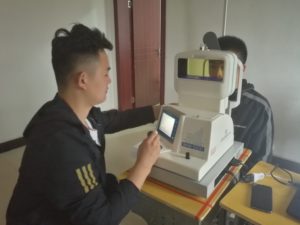May 1, 2020
By Krupa Philip, B. Optom, PhD, and Padmaja Sankaridurg, B.Opt, MIP, PhD
Brien Holden Vision Institute

Fig 1: Grand Seiko WAM autorefractor in use. Refractive error is measured at various distances to determine accommodative response.
Optical strategies such as orthokeratology and multifocal/extended depth of focus soft contact lenses are effective in slowing myopia, and their uptake is on the rise.1-4 In addition to correcting for the myopic refractive error, the lenses aim to control or reduce the hyperopic blur that results at the peripheral retina and/or hyperopic defocus at the central retina that occurs during accommodation. This reduction in hyperopic blur is achieved by having a zone/region/areas that have a power that is relatively more positive than the region that corrects for distance refractive error.
Hyperopic defocus that occurs at the retina with reduced accommodative effort is known as lag; some data indicates myopic eyes have greater or increased lag of accommodation, lower amplitude of accommodation, lower accommodative facility, reduced positive relative accommodation and an increased gradient AC/A ratio compared to non-myopes.5-9. However, other data show no difference in accommodative responses between myopic vs. non-myopic, progressing vs. stable myopes. Furthermore, results were found to vary based on the type of targets, experimental conditions, etc.10-13 Thus, the picture on whether myopic eyes suffer from some form of accommodative dysfunction is not clear. But operating under the assumption that there is hyperopic defocus due to accommodative lag, then the relatively positive power or ‘add’ power present in one or more areas in the multifocal contact lenses or induced as a result of treatment with ortho-k lenses may help to reduce the hyperopic defocus resulting from the accommodative lag and therefore, this should then slow eye growth.
While that is simple enough, there are few things to consider: a) if the multifocal contact lens or ortho-k treatment corrects for the lag of accommodation and brings the image closer to the retina, then this would reduce or eliminate the need for the eye to accommodate; b) when working at near distances, the plus or add portion reduces hyperopic defocus, but the distance portion of the lens induces hyperopic defocus. Therefore, one is led to wonder if the accommodative response of the eye continues to function normally or under or over accommodates with myopia control lenses and ortho-k lenses. And since accommodation and convergence are related, does one see any changes in binocular vision status?
Therefore, there are some important considerations.
- Is there a correlation between lag of accommodation to progression of myopia which then informs us if we need to manage accommodative dysfunction; and
- Is the accommodative effort (response) with multifocal contact lenses and ortho-k treatment normal, or is there an under or over accommodation (lag or lead)?
It is fair to say that so far the evidence has been inconclusive for both the above, but there appear to be specific trends to take note of.
Firstly, in children with myopia, accommodative lag was not associated with progression in some studies; 14,15 but there is evidence that it correlated with progression in others.16
The data is also inconclusive for accommodative response with myopia control lenses and ortho K treatment. Some evidence indicates a reduced accommodative response with lenses (or lag) over a range of vergences and, additionally, a shift towards exophoria.17-20 The plus power was considered to have reduced the defocus, decreased the need for accommodation (or relaxed accommodation), and possibly the decreased accommodative effort may have led to the exophoric shift. No changes were observed with accommodative facility or amplitude. But there is also some information to the contrary. Children were found to have accommodated normally at a near distance with a dual focus lens. Furthermore, the dual focus lens was shown to inhibit myopia progression, but there was no correlation between lag and progression.21 An increase in accommodative amplitude and a decrease in accommodative lag was also observed after orthokeratology wear in children.22,23
In other studies, a contact lens that incorporated negative spherical aberration (altered eye’s state to -0.1um) reduced the lag, i.e., improved the eye’s accommodative response for a short period (three months in a two-year study). Still, there was no effect of the lens on progression.16 A more recent study that used a multifocal lens with positive spherical aberration found that there was reduced accommodative response for all distances, especially for far (or increased lag). There was a correlation with lag to progression, and more importantly, eyes that normally accommodated with the lens had reduced progression.24
Why the variability? It is not well understood, and there are multiple factors to consider, such as age, magnitude of myopia, innate aberrations of the eye, lens design, technique, targets, vergences, etc. For example, it has been said that the accommodative response may vary as a function of the native spherical aberration of the eye and the interaction with the lens.25 Another study found reduced accommodative response and shift in exophoria with aspheric designs of multifocal lenses, but no differences with contact lenses designed exclusively for myopia control.26
Tips for Myopia Management
In summary, it is important to recognize that generally multifocal/extended depth of focus lenses slow myopia; the relationship with accommodation and how it might influence progression is unclear. The key is to evaluate the patient’s binocular vision status and accommodative response before lens fitting27, and at regular intervals after lens fitting and any changes observed with treatment placed in context of the patient’s baseline status and lens design/progression data. It may be even more critical to ensure that these are monitored regularly when contemplating combination therapies.
Fig 1: Grand Seiko WAM autorefractor in use. Refractive error is measured at various distances to determine accommodative response.
REFERENCES
- Chamberlain, P., et al., A 3-year Randomized Clinical Trial of MiSight Lenses for Myopia Control. Optom Vis Sci, 2019. 96(8): p. 556-567.
- Sankaridurg, P., et al., Myopia control with novel central and peripheral plus contact lenses and extended depth of focus contact lenses: 2 year results from a randomised clinical trial. Ophthalmic Physiol Opt, 2019. 39(4): p. 294-307.
- Wildsoet, C.F., et al., IMI – Interventions Myopia Institute: Interventions for Controlling Myopia Onset and Progression Report. Invest Ophthalmol Vis Sci, 2019. 60(3): p. M106-m131.
- Wolffsohn, J.S., et al., Global trends in myopia management attitudes and strategies in clinical practice – 2019 Update. Cont Lens Anterior Eye, 2020. 43(1): p. 9-17.
- Allen, P.M. and D.J. O’Leary, Accommodation functions: co-dependency and relationship to refractive error. Vision Res, 2006. 46(4): p. 491-505.
- Pandian, A., et al., Accommodative facility in eyes with and without myopia. Invest Ophthalmol Vis Sci, 2006. 47(11): p. 4725-31.
- Drobe, B. and R. de Saint-Andre, The pre-myopic syndrome. Ophthalmic Physiol Opt, 1995. 15(5): p. 375-8.
- Goss, D.A., Clinical accommodation and heterophoria findings preceding juvenile onset of myopia. Optom Vis Sci, 1991. 68(2): p. 110-6.
- Harb, E., F. Thorn, and D. Troilo, Characteristics of accommodative behavior during sustained reading in emmetropes and myopes. Vision Res, 2006. 46(16): p. 2581-92.
- Rosenfield, M., R. Desai, and J.K. Portello, Do progressing myopes show reduced accommodative responses? Optom Vis Sci, 2002. 79(4): p. 268-73.
- Yeo, A.C., K.K. Kang, and W. Tang, Accommodative stimulus response curve of emmetropes and myopes. Ann Acad Med Singapore, 2006. 35(12): p. 868-74.
- Gawron, V.J., Differences among myopes, emmetropes, and hyperopes. Am J Optom Physiol Opt, 1981. 58(9): p. 753-60.
- Fisher, S.K., K.J. Ciuffreda, and S. Levine, Tonic accommodation, accommodative hysteresis, and refractive error. Am J Optom Physiol Opt, 1987. 64(11): p. 799-809.
- Berntsen, D.A., et al., Accommodative lag and juvenile-onset myopia progression in children wearing refractive correction. Vision Res, 2011. 51(9): p. 1039-46.
- Koomson, N.Y., et al., Relationship between Reduced Accommodative Lag and Myopia Progression. Optom Vis Sci, 2016. 93(7): p. 683-91.
- Price, H., et al., The Cambridge Anti-myopia Study: variables associated with myopia progression. Optom Vis Sci, 2013. 90(11): p. 1274-83.
- Kang, P. and C.F. Wildsoet, Acute and short-term changes in visual function with multifocal soft contact lens wear in young adults. Cont Lens Anterior Eye, 2016. 39(2): p. 133-40.
- Altoaimi, B.H., et al., Accommodative Behavior of Young Eyes Wearing Multifocal Contact Lenses. Optom Vis Sci, 2018. 95(5): p. 416-427.
- Gong, C.R., D. Troilo, and K. Richdale, Accommodation and Phoria in Children Wearing Multifocal Contact Lenses. Optom Vis Sci, 2017. 94(3): p. 353-360.
- Gifford, K., et al., Near binocular visual function in young adult orthokeratology versus soft contact lens wearers. Cont Lens Anterior Eye, 2017. 40(3): p. 184-189.
- Anstice, N.S. and J.R. Phillips, Effect of dual-focus soft contact lens wear on axial myopia progression in children. Ophthalmology, 2011. 118(6): p. 1152-61.
- Yang, Y., et al., Accommodation function comparison following use of contact lens for orthokeratology and spectacle use in myopic children: a prospective controlled trial. Int J Ophthalmol, 2018. 11(7): p. 1234-1238.
- Batres, L., et al., Accommodation response and spherical aberration during orthokeratology. Graefes Arch Clin Exp Ophthalmol, 2020. 258(1): p. 117-127.
- Cheng, X., J. Xu, and N.A. Brennan, accommodation and its role in myopia progression and control with soft contact lenses. Ophthalmic Physiol Opt, 2019. 39(3): p. 162-171.
- Lipson, M.J., M.M. Brooks, and B.H. Koffler, The Role of Orthokeratology in Myopia Control: A Review. Eye Contact Lens, 2018. 44(4): p. 224-230.
- Schmid, K.L., et al., The effects of aspheric and concentric multifocal soft contact lenses on visual quality, vergence and accommodation function in young adult myopes, in ARVO. 2019, Investigative Ophthalmology and Visual Science.
- Gifford, K.L., et al., IMI – Clinical Management Guidelines Report. Invest Ophthalmol Vis Sci, 2019. 60(3): p. M184-m203.













